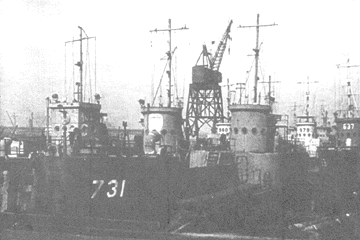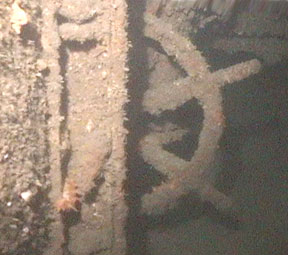Ace I
| Other Names: "Upside Down Wreck", ex LCI (L) 735 | Date of Sinking: April 29, 1948 | |||
| Rig/Type: LCI (Landing Craft Infantry) | Cause of Sinking: Probable Shell Fire | |||
| Length: 149.8' | Breadth: 23.2' | Tons: 96 Net | Cargo: None | |
| Built: Commercial Iron Works of Portland, Oregon, 1944 | Location: 7 miles south of San Pedro/Long Beach | |||
| Hull Construction: Steel | Depth: 125' | Visibility: 15-40+' | ||
The ACE I was originally built as the LCI (L) 735. Unlike other landing craft equipped with ramps, the LCIs had a pointed bow, but were equipped with narrow ramps that descended along her bows at a 45-degree angle.

A picture of the La Manana, another LCI used as a fishing
barge off
Redondo Beach after the war. Note the ramp just aft of the bow.
Her war career began on September 6, 1944, when she participated in the
Capture and Occupation of Palau Island in the Western Caroline Island Group until October
14, 1944. From March 26 to June 14, 1945, she participated in the Capture and
Occupation of Okinawa an Island in the Ryukua Island Group and from September 25 through
December 16, 1945 she served in the China Occupation Service. Shortly thereafter, she then
returned to the USA and was Decommissioned.
Built near the end of the war, LCI 735 quickly outlived her usefulness after little more
than two years. On December 6, 1946, she was one of five LCIs sold to National Metal &
Steel Corporation of Terminal Island. After salvaging her engines and machinery, her
hull was sold to W.S. Hume of Cabrillo Beach for use as a fishing barge and moored off
Dana Point in April of 1948. Just six days after obtaining a Certificate of
Enrollment and License which permitted her to operate legally, a storm came up and she
dragged anchor, coming to rest on the rocky shore at 10 PM on April 28.
The sole occupant, the caretaker Richard Floyd, jumped overboard and climbed up
on the bluff just north of Dana Point. Considered a
total loss, she was pulled off by the Pacific Atom and two Red-Stack tugs.
While under tow towards San Pedro/Long Beach harbor, she "became a menace to
navigation" and was sunk by the CG-83337 about 7 miles south off the breakwater.
Today, she is erroneously listed on charts and National Ocean Service records as the wreck marker at 33o 38' 50" 118o 11' 50"

Identical to the LCI 735, the LCI 731 is shown above at Terminal Island after the war, awaiting scrapping.
Diving the ACE I
At first, the ACE I appears to be anything but intriguing. Laying keel up, the hull resembles a large rock as there is little to attest that the bare hull was once a ship. The props, shafts, struts and rudders are missing (either salvaged during its conversion to a fishing barge or torn off during its stranding) and the odd lines of the bow that once formed the landing ramp are the only recognizable traits of the LCI's seemingly featureless hull. However, there are four holes--two on both sides of the bow and two more in the stern--that allow a diver access into the wreck's interior. Inside the bow, framework, complete with lightening holes, is visible overhead, attesting to the LCI’s modern construction. A large folding stock kedge anchor is plainly visible at the bow peak, partially buried in the wreckage.Elsewhere, a few holes near the water line allow little more than a dive light to peek in, but the engine space (less engine) is not accessible.
A large hole on the port quarter (right side--remember, it's upside down) permits easy access into the stern, Light from the opening on the opposite side illuminates the wreck's interior. Once inside, a bulkhead prohibits moving forward, but a small passageway through an open watertight hatch will allow the diver to swim a few feet back towards the stern. Through holes in the aft-most bulkhead, the auxiliary wheel is visible, hanging intact on its stanchion. But before you begin dusting off you mantle piece to make space for your trophy-to-be, keep in mind that the LCIs were built late in the war with very short expected lifespans. Brass was at a premium (remember the steel pennies of 1943) and wasn't to be wasted on an expendable landing craft
 .
.
The ACE I's steel auxilary steering wheel.
Despite rumors to the contrary, the wheel, stanchion and even the bell were made of steel. The only brass items discovered on the wreck were three portholes, likely added after the LCI was cut down to a fishing barge.
When the ACE I was discovered a few years ago by CWD members, some crude Syracuse china, the brass-plated bell, a coffee maker and three brass portholes were discovered. Since then divers have cut a small opening into the starboard side to gain access to the wheel and stanchion.
The ACE I's original builder's plaque. Believed to be cast of zinc, it was removed shortly after its salvage and is currently on display in the Brass Room of the Los Angeles Maritime Museum.
Given the distance from shore (just a quarter mile from the wreck of the Moody), the water clarity is generally improved and ranges from 15’-40’. At times, the current can exceed the swimming speed of a diver, requiring the use of a reel to ensure returning to the surface via the anchor line.
The ACE I isn't often visited by divers and a result, the marine life is unaccustomed to seeing divers and large codfish, sheepshead, and lingcod are frequently seen.
Given the depth, potential current and penetration, a dive to the ACE I should only be attempted by divers with the qualifications and experience to make such a dive. But for those wishing to dive a wreck over 150’ long that is relatively intact and penetrable, the ACE I is worth checking out.
| Like to learn more about this wreck? Visit our Guest Page to submit your inquiry. |
